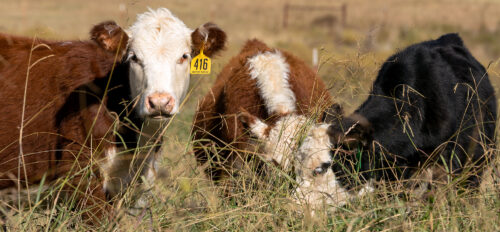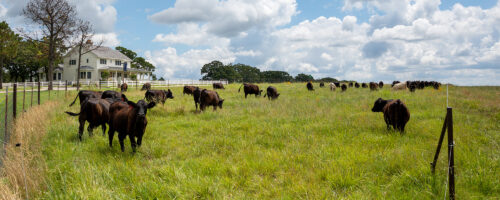Running a ranch today isn’t easy. Between unpredictable markets, rising input costs and weather extremes, many producers feel like they’re constantly working harder just to stay in place. But profitability doesn’t always come from doing more. Often, it comes from doing things differently.
“That’s the idea behind Noble Research Institute’s Profitability Essentials approach. Helping ranchers focus on practices that build resilience, improve land productivity and enhance their bottom line. These 10 principles offer practical ways to increase profit without sacrificing the health of your land, livestock or lifestyle,” says Patrick Jones, regenerative ranching advisor.
1. Profitability is a choice
Many ranchers fall into the trap of measuring success by how many cows they run or how much land they manage. But bigger isn’t always better, and harder work doesn’t always equal higher returns.
Profit doesn’t just happen. It’s intentional. The key isn’t more cattle or acres – it’s how thoughtfully you use and care for the ones you already manage.
Choosing profitability means tracking costs, questioning long-standing habits and making deliberate adjustments. It’s a shift in mindset. Instead of asking “How can I produce more?” the better question may be “How can I make more from what I produce?

2. Diversify for resilience
Nature thrives on diversity, and so can your ranch. Introducing a mix of grasses, legumes and forbs improves forage utilization, boosts soil health and provides insurance against drought and pests.
When you add diversity to your pastures, you build a buffer against drought, pests and unpredictable markets. A mix of grasses, forbs and legumes means your livestock have options, and so do you.
Producers who diversify forage systems often find their cattle stay healthier and their pastures recover faster. More plant diversity also means longer grazing seasons and less reliance on hay or supplemental feed. These savings go straight to the bottom line.
3. Focus on the soil
Soil health isn’t just an ecological concern; it’s the financial foundation of any ranch. Practices like adaptive grazing, limiting tillage and planting diverse species can improve soil fertility, water-holding capacity and organic matter. These improvements reduce the need for costly fertilizers and purchased feed.
Healthy soil is like a savings account for your ranch. When you invest in it through adaptive grazing or plant diversity, you gain long-term returns in fertility, forage and water holding capacity without the constant bill for outside inputs.
Think of soil as your ranch’s most valuable asset. Building its health pays dividends for years to come.

4. Explore cost-saving strategies
For many ranchers, the biggest threat to profitability isn’t low cattle prices – it’s high input costs. Fertilizer, fuel and feed can eat into margins quickly. Exploring ways to reduce reliance on these external inputs can open up room for profit.
Well-adapted forages, rotational grazing and water efficiency strategies all help reduce expenses. In many cases, the savings are just as valuable as a price increase at the sale barn.
5. Balance business and personal life
A profitable ranch should serve its people, not the other way around. Chasing production at the expense of time with family or personal health leads to burnout, not long-term success.
Profitability means creating room for your family, your health and your peace of mind.
Ranchers who intentionally carve out personal time often find they make clearer business decisions and are better able to weather the inevitable ups and downs.
6. Know when to pivot
Not every enterprise is worth continuing. Sometimes a cattle herd, hay operation or side business consumes more time and resources than it returns. Being willing to pivot, whether by downsizing, diversifying or exiting an enterprise, can save money and stress.
Sometimes the bravest thing a rancher can do is walk away from an enterprise that isn’t working. Pivoting doesn’t mean failure. It means choosing to align your ranch with your values and long-term profitability.
Evaluating enterprises annually, with both financial and personal goals in mind, keeps the ranch adaptable.
7. Capture market opportunities
Consumers today are more curious than ever about where their food comes from. Ranchers who share their story through direct marketing, niche labels or conservation certifications often capture higher prices and loyal customers.
Even if you sell through conventional markets, connecting your practices to consumer values can open doors to premiums or partnership opportunities.
8. Manage for the whole system
Ranching is a complex, interconnected system. Decisions about land management affect livestock health, which affects finances, which affects family stress. The cycle continues.
When you manage your ranch as a whole—land, livestock, people and finances—you realize how connected everything is.
Holistic management requires balance. Tools like grazing charts, financial budgets and family business meetings help ensure that no piece of the puzzle is neglected.

9. Learn from others
No rancher has to face challenges alone. Engaging with networks, whether local producer groups, online forums or regional workshops, provides new ideas, encouragement and proven strategies.
Collaboration accelerates innovation and helps avoid costly mistakes. Shared wisdom is often the most practical resource a rancher can tap.
10. Plan for the long-term
Ranching is not a short-term endeavor. Every decision, from stocking rates to soil practices, has ripple effects years down the road. Long-term planning is essential for both profitability and legacy.
“Regenerative practices aren’t a quick fix,” says Jones. “But if you set clear goals and take it step by step, you’ll build a ranch that’s not only profitable today but sustainable for your kids and grandkids.”
Clear written goals, periodic check-ins and adaptive strategies help ranchers stay focused on the big picture, even when daily challenges threaten to distract.
Pulling it all together
At its core, ranch profitability isn’t about squeezing more out of the land or yourself. It’s about aligning your practices, values and goals into a system that works.
Courses like Noble Profitability Essentials and Business of Grazing bring these principles to life with real-world strategies and producer stories. Tapping into resources like these won’t just offer new ideas; they’ll help you develop actionable plans for applying them to your operation, which is key.
The message is simple: profitability isn’t out of reach, and it doesn’t require sacrificing your land or lifestyle. By making intentional choices, building resilience and planning for the future, ranchers can create operations that thrive for generations.



Comment